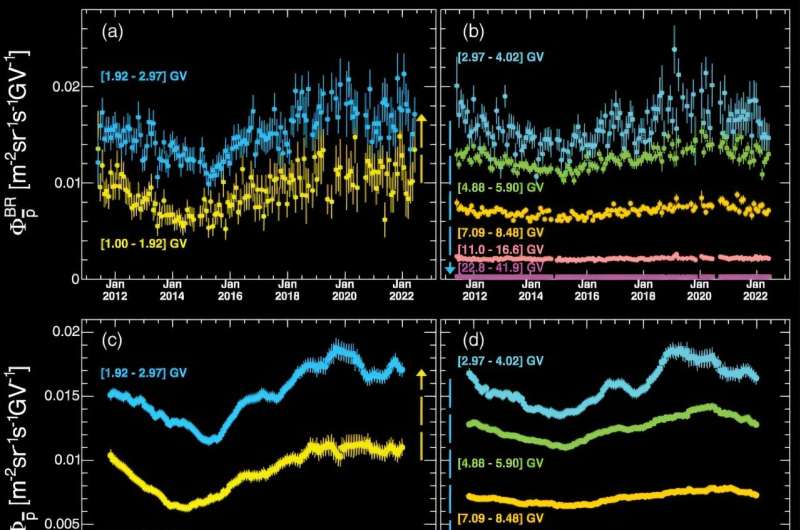A large team of researchers working on the Alpha Magnetic Spectrometer Collaboration, which has been analyzing eleven years’ worth of data from the Alpha Magnetic Spectrometer (AMS) aboard the International Space Station, has found trends in the number of particles moving around in the heliosphere and in the way they interact with one another.
The team has published two papers in the journal Physical Review Letters; one describing trends they found surrounding antiproton and elementary particle behavior over a single solar cycle and the other covering solar modulation of cosmic nuclei behavior, also over a single solar cycle.
Prior research has shown that the sun follows a cycle that repeats itself every 11 years. The AMS has been running for more than 11 years, but the researchers working on both efforts focused on conditions during just one cycle. They wanted to know how the sun impacted energy particles in the heliosphere and beyond.
Prior research has shown that the strength of the heliospheric magnetic field rises and falls over a predictable 11-year cycle, exerting a variable force on the charged particles that are moving around in the heliosphere, some of which emanate from the sun and the planets and others that are part of the stream of galactic cosmic rays (GCRs) that come from places beyond the solar system. The AMS measures the masses and energies of all such particles when struck.
In looking at the data from the AMS for one solar cycle, the researchers found some trends in the number of particles that struck the sensor and how they interacted with each other.
In one part of their effort, the researchers focused mainly on GCR antiprotons and the way they behave in the heliosphere due to changes in the heliospheric magnetic field and also in interactions with other particles—all of which were reflected in the charges of the particles that wound up colliding with the ACM.
In the second part of their effort, they looked at properties of cosmic nuclei, He, Be, Li, B, N, C, and O fluxes over a single solar cycle and found some similar variations in time and amplitudes, which they were able to correlate with differences in cosmic nuclei fluxes.
More information:
M. Aguilar et al, Antiprotons and Elementary Particles over a Solar Cycle: Results from the Alpha Magnetic Spectrometer, Physical Review Letters (2025). DOI: 10.1103/PhysRevLett.134.051002
M. Aguilar et al, Solar Modulation of Cosmic Nuclei over a Solar Cycle: Results from the Alpha Magnetic Spectrometer, Physical Review Letters (2025). DOI: 10.1103/PhysRevLett.134.051001
© 2025 Science X Network
Citation:
Solar cycle study reveals trends in charged particle numbers and interactions (2025, February 5)
retrieved 5 February 2025
from https://phys.org/news/2025-02-solar-reveals-trends-particle-interactions.html
This document is subject to copyright. Apart from any fair dealing for the purpose of private study or research, no
part may be reproduced without the written permission. The content is provided for information purposes only.

